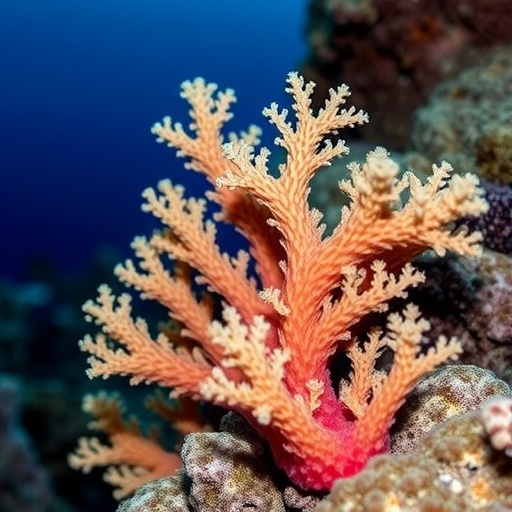Symbiodiniaceae, the crucial symbiotic algae that play an integral role in coral health, have been observed experiencing significant shifts in their composition over the last decade, particularly on the hottest coral reefs on Earth. This revelation emerges from a comprehensive study conducted by Fiesinger, Alderdice, and Colin, published in the esteemed journal Coral Reefs. Understanding these dynamics is vital as they can profoundly influence coral resilience and their ability to cope with rising water temperatures due to climate change.
The study meticulously analyzed the biogeographical and thermotolerance properties of Symbiodiniaceae, focusing on specific coral species inhabited by these algae. Researchers discovered that with the increasing severity of marine heatwaves, certain Symbiodiniaceae genotypes have become more prevalent, while others are declining. This shift not only impacts the ecological balance within these ecosystems but also poses a significant threat to coral’s capacity to tolerate stressors, including thermal stress and ocean acidification.
Heat stress has been a focal point of coral research, as rising sea temperatures have been linked to mass bleaching events. These events occur when corals expel their symbiotic algae, leading to a loss of color and essential energy sources. The study highlights that the symbiont shift observed in the last decade may be a double-edged sword. While some algal types confer better heat tolerance, others may not offer the necessary support for coral survival under extreme conditions. This complex interplay raises questions about the long-term viability of coral reefs in a warming ocean.
The researchers utilized advanced molecular techniques to analyze samples collected from various coral reefs around the world. By employing DNA metabarcoding and ecological modeling, they were able to decipher the intricate relationships between different Symbiodiniaceae genotypes and their coral hosts. The findings indicate that thermal environments are a driving force behind the distribution of these algal symbionts. Understanding these relationships is crucial, as shifts in symbiotic partnerships could dictate future coral community structures amidst ongoing climate challenges.
Moreover, the study sheds light on how anthropogenic factors, such as nutrient loading and coastal development, intertwine with climate change to exacerbate the situation. Nutrient enrichment can lead to opportunistic algae blooms, which could further overshadow the native Symbiodiniaceae populations crucial for coral health. Hence, the dual pressures from climate change and human activity compel scientists to reconsider the management strategies for coral reefs, taking into account the symbiotic relationships that underpin these ecosystems.
In addition to thermal tolerance, the research also discusses the ramifications of Symbiodiniaceae shifts on the overall biodiversity of coral reefs. Coral species that rely on specific algal symbionts may find themselves at a disadvantage if those symbionts become less available due to changing environmental conditions. This can prompt a cascading effect throughout the reef ecosystem, potentially leading to reduced biodiversity and altered food webs.
One of the most striking conclusions of the study is the resilience showcased by certain coral species in adapting their symbiotic relationships in response to environmental change. Some corals exhibit a remarkable capacity to switch their symbiotic partners from less heat-tolerant algae to more resilient strains. This flexibility could be key to the survival of corals in increasingly hostile environments. However, this adaptability is not uniform across all species or reef locations, underscoring the need for targeted conservation efforts tailored to specific ecological contexts.
As global temperatures continue to rise, the implications of these findings underscore an urgent need for increased monitoring and protective measures for coral reefs. Various approaches, such as the establishment of marine protected areas and restoration initiatives, could play a pivotal role in safeguarding these ecosystems. By prioritizing research into the dynamics of symbiosis and thermal tolerance, conservationists can better equip coral reefs to withstand the trials posed by climate change.
It is necessary to engage communities and policymakers in discussions about the importance of preserving coral reefs as they harbor immense biodiversity and provide invaluable services to humanity. Raising awareness about the shifts in Symbiodiniaceae composition should galvanize support for research funding and public education on marine ecosystems. Emphasizing the economic and ecological significance of healthy coral reefs can foster a culture of stewardship and responsibility towards these vulnerable habitats.
In conclusion, the recent study on Symbiodiniaceae shifts highlights a critical aspect of coral ecology that can no longer be overlooked. The complex relationship between corals and their algal symbionts serves as a window into the broader challenges faced by coral reefs under climate change. As we forge ahead, it is only through dedicated research efforts, community engagement, and robust conservation strategies that we can hope to mitigate the impending crises faced by these irreplaceable ecosystems.
As we reflect on the fate of the hottest coral reefs on Earth, the message is clear: understanding and preserving the intricate relationships between corals and their symbiotic partners will be essential for their survival amid the disruptions caused by climate change. The study by Fiesinger and colleagues marks a significant step in disentangling the complexities of coral resilience, but it also highlights the urgency of action needed to protect these vital marine ecosystems for future generations.
Subject of Research: The shifts in Symbiodiniaceae on the hottest coral reefs over the last decade.
Article Title: Symbiodiniaceae shifts over the last decade on the hottest coral reefs on Earth.
Article References:
Fiesinger, A., Alderdice, R., Colin, L. et al. Symbiodiniaceae shifts over the last decade on the hottest coral reefs on Earth. Coral Reefs (2025). https://doi.org/10.1007/s00338-025-02767-x
Image Credits: AI Generated
DOI:
Keywords: Symbiodiniaceae, coral reefs, climate change, thermal tolerance, biodiversity, marine ecosystems, conservation.




